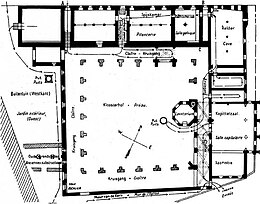Saint Bavo Abbey
The Saint Bavo Abbey (ndl. Sint-Baafsabdij ) was an abbey in the Flemish city of Ghent near the confluence of the Leie and Scheldt rivers , in that part of the city that was called Ganda in ancient times. It was founded in the 7th century by Amandus von Gent , a missionary from Aquitaine .
Amandus and Bavo
In the period between 629 and 639 Amandus tried to convert the inhabitants of Gentgau (pagus Gandao) , initially with little success. He met resistance and is said to have been thrown into the water several times by the Ghent people. He eventually relied on the help of ransomed prisoners and slaves whom he had baptized and slowly became more successful. A miracle in which he brought an executed person back to life is said to have contributed significantly to this.
Amandus settled on the domain of Blandinium (or Blandinberg), which in Gallo-Roman times belonged to a certain Blandinus. With the help of the Merovingian King Dagobert I, he founded a monastery there, which over time grew into the abbey that is now known as St. Peter's Abbey .
Amandus founded another monastery at the not far away Portus Ganda . A few years after the foundation, Allowin vom Haspengau entered the Gandakloster and took the name Bavo there. In the 9th century the monastery, which later grew into an abbey, was named after him.
History of the abbey
The youngest son of Charlemagne , Ludwig the Pious , made the Karlsbiograph Einhard († 840) the first abbot of Ganda. This probably also gave the order to build the first stone church. Ganda was then a royal monastery and was therefore under the direction of a lay abbot. At that time the residents were not monks, but secular canons . Einhard and Bavo ensured the first period of prosperity.
Two Viking invasions in the second half of the 9th century were fatal for the abbey. In the winter of 879/880 they set up their winter quarters here. The men of God sought their salvation in Laon , since the lay abbot was also Lord of Laon at the same time. They returned after an absence of nearly 50 years. The buildings were in poor condition and the domain had been seized by Arnulf I the Great, Count of Flanders, who had a strong connection with Saint Peter's Abbey. At the suggestion of the Bishop of Doornik, Arnulf rebuilt the abbey and subjected it to the rules of St. Benedict in 946 . From then on it was headed by an abbot.
The Roman-German Emperor Otto II. Looked at the Abbey a strategic defense point in his dispute with the French King Louis V. The Scheldt was still border between the two young rich.
The abbey church was built under Abbot Odwin (981–998), of which the oldest wall in Ghent remains. It was nearing its definitive completion at the beginning of the 11th century. Under the direction of Odwinus, the abbey was able to enter into serious competition with St. Peter's Abbey.
One of the pilgrims who came to Saint Bavo's Abbey was St. Macharius . He died of the plague there, so that a cult around his person arose here. He became a plague and parish saint and gave his name to the parish church in the area. Most of the buildings (parts) still in existence today date from the 10th to 12th centuries.
In the following centuries the Sankt Bavo village with its own parish church and hospital developed to the east of the abbey . Well-known and important people visited the abbey, and John of Gent, the first Duke of Lancaster and fourth son of the English King Edward II , was even born here in 1340.
Decline
Abbot Lucas Munich reformed the regular Benedictine abbey in 1536/37 to a secular chapter of canons under the direction of a provost with a miter. On July 31, 1537, the monks took off their habit and approved the chapter statutes, which meant they were no longer bound by the vow of poverty and received other benefits. However, they were required to attend the choir prayers.
In 1540, Emperor Charles V gave the order to demolish large parts of the abbey, including the impressive Romanesque abbey church, the Sankt Bavo village and the Parish church. This razing was one of the conditions recorded in the Concessio Carolina . Instead of the abbey, a fortress was built, the Spaniard Fort. Against his will and despite his pleading, the chapter had to move to what was then St. John's Church, which accordingly first became St. Bavo's Church and later became a cathedral.
gallery
Document from Louis the Pious in the Ghent City Museum , in which Ludwig confirms the immunity of the abbey and royal protection granted by his father Charlemagne .
See also
Web links
Coordinates: 51 ° 3 ′ 13.3 " N , 3 ° 44 ′ 10.7" E









